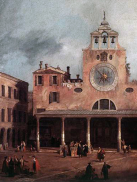January 2, 2013
Mueller, Reinhold C. (1987) I banchi locali a Venezia nel Tardo Medioevo. Studi Storici, 28/1: 145-55.



There is a lot to be admired in Austrian economists, their resilience, their attachment to simple elegant ideas and their sound understanding of the long-term factors that give the economy its cyclical nature. But one must admit that their Ludite-like hatred for finance is to the very least puzzling. They claim to trust nothing but gold and they would like to see the activity of banks restricted to little more than a locker service. Their trust in free market and in the adaptive nature of human ingenuity ends at the door of their local branch of HSBC. Read the rest of this entry »
 1 Comment |
1 Comment |  Economic History, Europe, Middle Ages, reading notes | Tagged: 1200s, 1300s, 1400s, 1500s, Banco del, bank, banking, banks, central banking, finance, Italy, Venice |
Economic History, Europe, Middle Ages, reading notes | Tagged: 1200s, 1300s, 1400s, 1500s, Banco del, bank, banking, banks, central banking, finance, Italy, Venice |  Permalink
Permalink
 Posted by Ben
Posted by Ben
December 20, 2010
Saito, Osamu and Tokihiko Settsu (2006) Money, credit and Smithian growth in Tokugawa Japan. Hitotsubashi University. Institute of Economic Research. Discussion Paper #139.

In Osaka, Japan’s commercial capital, under the Tokugawa, rich merchants began to add to their functions that of lender to the mighty overlords (daymo) who needed to transform the production of their domain in bullion in order to cover their expenses in Edo and the taxes due to the Shogun (p.2). At the time, the country was segmented in small local capital market and no security was traded over the whole country. Despite those limitations, the rural industries did grow over the period, yet for that they had to have access to some fundings. Where did this capital come from? (p.3)
This wholesaler system arose in replacement of an inexistent banking sector (p.4). However this organization favored greatly the Osaka merchant who managed to impose de facto their service as a necessary precondition to any industrial or agricultural endeavor (p.5). But at that time, local merchants took on Osaka’s oligopoly.
To develop the production and trade of a wealth of proto-industrial products, they started delivering themselves those products to Edo, thus by-passing the Osaka intermediaries. Local lords backed these initiatives, for instance by issuing bank notes (hansatsu) to remedy to the dramatic shortages of money (p.9). However often successful, these initiatives led to a quick segmentation of the Japanese capital market and each of these small areas suffered from high interest rates (more than 18%), while at the same time interest rates in Osaka kept following (p.10).
A system, close to the earlier one arose after the Meiji Revolution, but this time with several commercial cities as the center of the operations instead of Osaka alone (p.13).
 3 Comments |
3 Comments |  Asia, Early Modern, Economic History, reading notes | Tagged: Edo, finance, finance and growth, financing industry, hansatsu, Japan, Osaka, proto-industry, rural industries, Tokugawa, wholesalers |
Asia, Early Modern, Economic History, reading notes | Tagged: Edo, finance, finance and growth, financing industry, hansatsu, Japan, Osaka, proto-industry, rural industries, Tokugawa, wholesalers |  Permalink
Permalink
 Posted by Ben
Posted by Ben
December 13, 2010

Oppers, Stefan E. (1993) The Interest Rate Effect of Dutch Money in Eighteen-Century Britain. The Journal of Economic History, 53/1: 25-43.
Dutch citizens invested heavily in Britain over the 18th century. Even though the English themselves regarded this phenomenon as a necessary evil, it greatly help the Crown to levy the necessary capital for its expenses over the century (p.28). In the 1740s Dutch financiers in London had become critical for the funding of the government’s deficit. To a large extent it can even be said that the Seven Years War was won thanks to foreign money.
Read the rest of this entry »
 Leave a Comment » |
Leave a Comment » |  Early Modern, Economic History, Europe, reading notes | Tagged: 1700s, bonds, Britain, England, finance, financial history, France, French Wars, Loans, Netherlands, public debt, public finance, Seven Years War, United Kingdom, United States |
Early Modern, Economic History, Europe, reading notes | Tagged: 1700s, bonds, Britain, England, finance, financial history, France, French Wars, Loans, Netherlands, public debt, public finance, Seven Years War, United Kingdom, United States |  Permalink
Permalink
 Posted by Ben
Posted by Ben
December 9, 2010
Hoffman, Philip T., Gilles Postel-Vinay and Jean-Laurent Rosenthal (2001) Notaries, Banking and the Expansion of Credit in Old-Regime Paris, chapter 7 in Priceless Markets. The Political Economy of Credit in Paris, 1660-1870. University of Chicago Press, Chicago and London; p.136-176.

Some of the ideas developed in this chapter have been presented elsewhere, so this summary concentrates on the what’s new.
Evidence indicates that in the second quarter of the 18th century, some Parisian notaries were venturing away from the role of brokers between creditors and debtors they had acquired since the mid 1600s. In effect some of them were filling the position left empty by the absence of deposit banks (p.138). They were accepting interest-bearing deposits redeemable on demand and investing the money in different longer term assets such as bills of exchange, government debt and loans to individuals.
Moral hazards
Read the rest of this entry »
 Leave a Comment » |
Leave a Comment » |  Early Modern, Economic History, Europe, reading notes | Tagged: 1700s, finance, financial intermediation, France, notaries, Paris |
Early Modern, Economic History, Europe, reading notes | Tagged: 1700s, finance, financial intermediation, France, notaries, Paris |  Permalink
Permalink
 Posted by Ben
Posted by Ben
January 16, 2010
Béguin, Katia (2005) La circulation des rentes constituées dans la France du XVIIe siècle. Une approche de l’incertitude économique. Annales. Histoire, Sciences Sociales, 60/5 : 1229-1244.
Vodpod videos no longer available. Molière “L’Avare” Read the rest of this entry »
 Leave a Comment » |
Leave a Comment » |  Early Modern, Economic History, Europe, reading notes | Tagged: 1600s, Ancien Regime, bonds, Colbert, finance, financial markets, France, investment, Louis XIV, public finance, rente |
Early Modern, Economic History, Europe, reading notes | Tagged: 1600s, Ancien Regime, bonds, Colbert, finance, financial markets, France, investment, Louis XIV, public finance, rente |  Permalink
Permalink
 Posted by Ben
Posted by Ben
December 25, 2009
Kindleberger, Charles P. (1991) The economic Crisis of 1619 and 1623. The Journal of Economic History, 51/1 : 149-175.



Introduction
The early European 17th century has commonly been described as the troublesome transition from a medieval to a modern economy (p.149). The multi-layered crisis of 1619-23 is a perfect embodiment of the woes of the time. However, the author’s “interest in that crisis does not concern its potential role as a catalyst of modern economies, but rather its function in the mechanism for the spread of a primarily financial crisis from one part of Europe to another” (p.150). Read the rest of this entry »
 Leave a Comment » |
Leave a Comment » |  Early Modern, Economic History, Europe, reading notes | Tagged: 1600s, 17th century crisis, coins, England, free banking, Germany, Gersham's Law, Hayek, Kindleberger, Kippermünze, Klipperzeit, mint, monetary, monetary famine, monetary stability, money, Poland, recoinage, Thirty Years War, Wipperzeit, Wisselbank |
Early Modern, Economic History, Europe, reading notes | Tagged: 1600s, 17th century crisis, coins, England, free banking, Germany, Gersham's Law, Hayek, Kindleberger, Kippermünze, Klipperzeit, mint, monetary, monetary famine, monetary stability, money, Poland, recoinage, Thirty Years War, Wipperzeit, Wisselbank |  Permalink
Permalink
 Posted by Ben
Posted by Ben
December 19, 2009
Caporale, Tony and Kevin B. Grier (2000) Political Regime Change and the Real Interest Rate, Journal of Money, Credit and Banking, 32/3: 320-334.



Intro
A number of influential macroeconomic models, from Keynes to the monetarists, assume that real interest rates (i.e. discounted for inflation) change over time and are sensitive to their political environment, other words that they are policy variant. However this assumption has not been empirically tested, should this assumption be in fact contradicted, it would have important repercussions on these models’ viability. Moreover, the policy-variant hypothesis apparently conflicts with Eugene Fama’s conclusion that the mean of the real rate is essentially constant (p.322). The literature has found to match Fama’s views more closely with reality: real interest rates are “essentially constant over long periods of times but subject to infrequent mean shifts that are not related to policy regime changes”. Read the rest of this entry »
 Leave a Comment » |
Leave a Comment » |  America, Economic History, economics, reading notes | Tagged: 1900s, Bush, Carter, interest rate, Johnson, Kennedy, Nixon, policy, politics, Reagan, real interest rate, USA |
America, Economic History, economics, reading notes | Tagged: 1900s, Bush, Carter, interest rate, Johnson, Kennedy, Nixon, policy, politics, Reagan, real interest rate, USA |  Permalink
Permalink
 Posted by Ben
Posted by Ben
November 26, 2009
Coates, John M., Mark Gurnell and Aldo Rustichini (2009) Second-to-fourth digit ratio predicts success among high-frequency financial traders. Proceedings of the National Academy of Science, 106/2: 623-8.



Introduction
What does traders’ success on the market floor depend on? Earlier studies have shown that one’s level of testosterone did affect one’s daily results. Since “prenatal androgens have organizing effects on the developing brain, increasing its later sensitivity to […] testosterone”, it would make sense that prenatal androgens also have a structural effect on a trader’s results on the long term. Read the rest of this entry »
 5 Comments |
5 Comments |  economics, reading notes, theory | Tagged: 2D:4D, biology, City of London, determinism, hormones, human behaviour, noise trading, second-to-fourth digit ratio, stock-market, testosterone, traders, Wall Street |
economics, reading notes, theory | Tagged: 2D:4D, biology, City of London, determinism, hormones, human behaviour, noise trading, second-to-fourth digit ratio, stock-market, testosterone, traders, Wall Street |  Permalink
Permalink
 Posted by Ben
Posted by Ben
November 25, 2009
Saad, Gad and John G. Vongas (2009) The effect of conspicuous consumption on men’s testosterone levels. Organizational Behavior and Human Decision Processes, 110/2: 80-92.



Introduction (longue one)
Thorstein Veblen coined the expression conspicuous consumption in 1899 to refer to goods which principal aim was to be displayed, advertise one’s wealth and impress one’s peers (p.80). In other words, it makes one’s fortune obvious by stressing one’s ability to waste. Read the rest of this entry »
 2 Comments |
2 Comments |  reading notes, theory | Tagged: Amotz Zahavi, behavioral economics, car, conspicuous consumption, Evolutionary Psychology, neuroeconomics, Porsche, psychology, sexual selection, status, status-enhancement, testosterone, Thorstein Veblen |
reading notes, theory | Tagged: Amotz Zahavi, behavioral economics, car, conspicuous consumption, Evolutionary Psychology, neuroeconomics, Porsche, psychology, sexual selection, status, status-enhancement, testosterone, Thorstein Veblen |  Permalink
Permalink
 Posted by Ben
Posted by Ben
November 21, 2009
DuPlessis, Robert S. and Martha C. Howell (1982) Reconsidering the Early Modern Urban Economy : The Case of Leiden and Lille. Past and Present, 94/, 49-84.



In Marx’s view, capitalism had arisen in the late Middle Ages out of a production system dominated by lords and guilds. In this framework, urban economies can be regarded as the craddle of capitalism (p.44), the places where capital and labour were separated through the use of putting-out, or the hiring of a migrant or female workforce (p.45). However some cities, such as Leiden and Lille where artisans remained proprietors of their means of production, still managed to integrated the very competitive European textile market (p.46). Read the rest of this entry »
 Leave a Comment » |
Leave a Comment » |  Early Modern, Economic History, Europe, reading notes | Tagged: 1500s, 1600s, 1700s, capitalism, Dutch revolt, Leiden, Lille, Low Countries, Marxist history, proto-industrialization, textile, transition to capitalism, urban economy, weaver |
Early Modern, Economic History, Europe, reading notes | Tagged: 1500s, 1600s, 1700s, capitalism, Dutch revolt, Leiden, Lille, Low Countries, Marxist history, proto-industrialization, textile, transition to capitalism, urban economy, weaver |  Permalink
Permalink
 Posted by Ben
Posted by Ben
October 24, 2009
Murphy, Anne L. (2009) Trading options before Black-Scholes: a study of the market in late seventeenth-century London. Economic History Review, 62/1: 8-30.

The ledger of the financial broker Charles Blunt contains the details of some 1,500 transactions realized between 1692 and 1695, about a third of which regard the then novel trade in equity options (p.9). The technique had arisen in the 1620s in the commodity market and was proving very useful in the decade following the Glorious Revolution, when some 100 joint-stock companies were floated in London (p.10). During the boom of the early 1690s, it is likely that “several thousand derivatives were transacted each year”.
Read the rest of this entry »
 4 Comments |
4 Comments |  Early Modern, Economic History, Europe, reading notes | Tagged: 1600s, capital market, derivative, early finance, England, exchange, finance, financial history, financial innovation, financial instruments, Glorious Revolution, joint stock companies, London, stock-market, stockjobbers |
Early Modern, Economic History, Europe, reading notes | Tagged: 1600s, capital market, derivative, early finance, England, exchange, finance, financial history, financial innovation, financial instruments, Glorious Revolution, joint stock companies, London, stock-market, stockjobbers |  Permalink
Permalink
 Posted by Ben
Posted by Ben
October 20, 2009
Seurot, François (2002) “Les crises bancaires en Italie au Moyen Age: un essai d’applicationn de la théorie de Minsky-Kindleberberger”, paper presented at the XIX Journée d’économie monétaire et bancaire, 21p.
![T970392A[1] T970392A[1]](https://premodeconhist.files.wordpress.com/2009/10/t970392a1.jpg?w=450&h=296)
This paper is available online (pdf).
Following a long tradition, Minsky and Kindleberger [1996] have based their analysis of financial crises in the early modern and modern periods on their vision of credit as intrinsically unstable and thus naturally prone to crashes. Their model is based on five steps:
- An exogenous shock modifies the incentive system the economy is based upon.
- These new incentive channel credit toward a given sector and produces a localized economic boom.
- Euphoria leads to the overestimation of the ROI and to overtrading.
- Fundamentals are reconsidered and credit dries up.
- Torschlusspanik, or bank rush (p.1). Read the rest of this entry »
 Leave a Comment » |
Leave a Comment » |  Economic History, Europe, Middle Ages, reading notes | Tagged: 1300s, 14th century crisis, Austrian economics, banking, banking crisis, banks, finance, financial crises, financial instability, Florence, il re d'Inghilterra non paga, Italy, Vienna school |
Economic History, Europe, Middle Ages, reading notes | Tagged: 1300s, 14th century crisis, Austrian economics, banking, banking crisis, banks, finance, financial crises, financial instability, Florence, il re d'Inghilterra non paga, Italy, Vienna school |  Permalink
Permalink
 Posted by Ben
Posted by Ben






 Posted by Ben
Posted by Ben 


















![T970392A[1] T970392A[1]](https://premodeconhist.files.wordpress.com/2009/10/t970392a1.jpg?w=450&h=296)